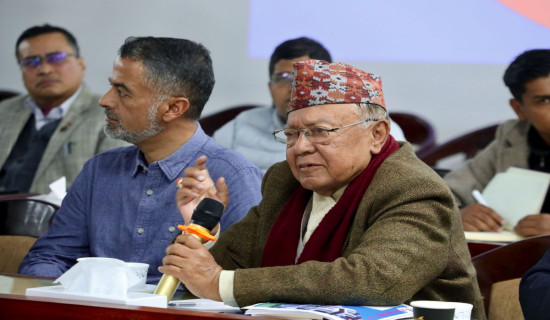- Monday, 22 December 2025
Beekeepers worry for lack of market for honey
By Hari Prasad Koirala,Urlabari, Apr. 16: Beekeepers in Urlabari of Morang are worried after being unable to sell honey, which they produced exceeding their expectation.
Abou 24 farmers in the Urlabari area are engaged in commercial honey production, while 68 farmers have more than 10 beehives each.
This year, mustard has bloomed well. One and a half times more honey was produced from mustard sources this year than last year. Similarly, there was good production of honey from buckwheat and Filunge.
At present, farmers are grazing their bees in the forest area. The production from wild sources has doubled compared to last year, said Bhola Raj Pokharel, the operator of Lekali Bee and Agriculture Firm.
According to him, he has now accumulated 1,200 kg of honey.
“All the pots have been filled, but there is no sale, there is a shortage of pots to keep the honey,” he said. “We engaged in honey production after the government encouraged us to produce honey. So, now the government should facilitate the sale of honey.”
Bodh Raj Khatiwada of Urlabari Municipality-3 has produced 2,500 kg of honey this season. “But, there is no business. To stop the business, hundreds of thousands have been invested. To continue, there is no business,” he said.
Khatiwada, who is keeping 110 beehives, said that the government is selling broiler chickens, eggs and Horlicks under the name of maternity nutrition programme.
“If a programme is introduced to sell one kg of honey, half the problems of bee farmers will be solved,” he said.
Another beekeeper Ramesh Khadka of Urlabari Municiplaity-2, Katahare is even more stressed. Even though the honey produced with painstaking efforts is full in the house, there is no money to spend in the pocket, he said.
Khadka said, “The enthusiasm with which we started beekeeping is not same now. The local government gave us a subsidy for honey harvesting. It gives a subsidy from time to time to save the bees. However, it does not facilitate for the sale of honey.” According to him, he currently has 700 kg of honey.
In the past, honey was used only for offering in worship. However, nowadays people consume honey daily. But as Indian honey comes at a cheaper price, there is no trade of Nepali honey, said Ambika Prasad Luintel, head of the agriculture branch of Urlabari Municipality.
Luintel also produces honey commercially. Luintel currently has 500 kg of honey, while he has already sold around 100 kg of honey.
He said, “The colour of honey varies according to the source, season and geography whereas the honey imported from India is always of the same colour. That is why consumers look for honey of the same colour. When they do not see the same colour, they blame that sugar has been added to the honey.”
Similarly, Ananta Ram Khatiwada of Urlabari-4 has 400 kg of honey. “I have not sent relatives who come empty-handed. But no one comes to buy,” he said.
According to Devraj Neupane, Information Officer of the Trade and Export Promotion Centre, Biratnagar, around 4,486 kg of honey worth Rs. 27.37 million has been exported from Nepal in the last six months of the current fiscal year.
During the same period, 24,794 kg of honey worth Rs. 57.25 million has been imported from third countries, including India. According to the statistics, average price of imported honey is Rs. 279 per kg, while honey exported from Nepal is an average of Rs. 6,100 per kg. Nepali honey is exported as medicine.
Similarly, in the fiscal year 2022/23, 10,879 kg of honey worth Rs. 57.47 million was exported from Nepal. In the same year, 88,471 kg of honey worth Rs. 176.17 million was imported.
Although Nepali farmers have continuously increased their production of honey, there are problems in exports.
According to Subash Chandra Ghimire, central president of the Federation of Nepal Beekeepers, currently 4,945 tonnes of honey is produced by farmers registered with the Federation. In the last few years, 6,000 tonnes of honey have been consumed in the Nepali market.
There is a shortfall of around 1,000 to 1,500 tonnes of honey in Nepal. However, as consumers do not understand the quality and use of honey, Nepali production is wasted and inedible honey is sold, he said.






-original-thumb.jpg)









